
Latest on Miramichi Salmon Conservation and More!
Fishing Friends – It has been a while since I’ve had some optimistic news to report on the ongoing attempts to turn around the decline of the Miramichi River Atlantic salmon population. I’m happy to report, though, that the landscape may be changing.
Let’s do a little background review. From what I can gather there are three basic problems facing the Miramichi salmon:
First, is a general backdrop of poor sea winter survival that is effecting almost all Atlantic salmon populations on both sides of the Atlantic Ocean. In fact it seems to be somewhat worse in Europe than on our side of the ocean.
What is the cause of this mortality? Scientists and fishery managers are uncertain about which of the several degrading factors is the main culprit. Illegal harvest and/or bycatch of Atlantic salmon by commercial fishing is one factor, and a very uncertain one. I read recently that around 50% of high seas fishing is IUU (Illegal, Unreported, Unregulated). Given the salmon’s long and dangerous migration route this could be a significant issue. Canadian scientist Michael Dadswell has been the most assertive about this claim. His papers on the subject are quite convincing. You can find the paper at this link.
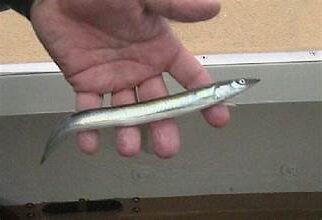
Sand Lance, commonly known as sand eels are important Atlantic salmon forage. The salmon’s fondness for these long, thin fish prompted Richard Waddington to design his famous shank that has been used to tie a few million Willy Gunn flies.
Also, key forage such as sand eels (sand lance) and capelin are fished very hard and populations are at or near record low levels. This scarcity causes the salmon to have to search harder to find food, consuming valuable energy and exposing them to risks from predators.
Another factor affecting high seas mortality may be ocean warming. This changes the locations of forage, and as in the previous paragraph may be making it more difficult for the salmon to efficiently capture the prey needed to have a successful sea-winter experience. It may also make the journey back and forth from spawning rivers to winter feeding grounds longer and more precarious.
Second, is the issue of unusual predation. Fingers are pointed at seals, mergansers, even sharks as important predators. And while these predators have always been there, some, like seals, seem to have increased greatly. I see that in Scotland they are now giving permits to cull “sawbills” which is a local term for fish eating birds such as mergansers and cormorants. Seals may very well be a problem. It is hard to get one’s head around how and why seal populations have expanded in the face of diminishing
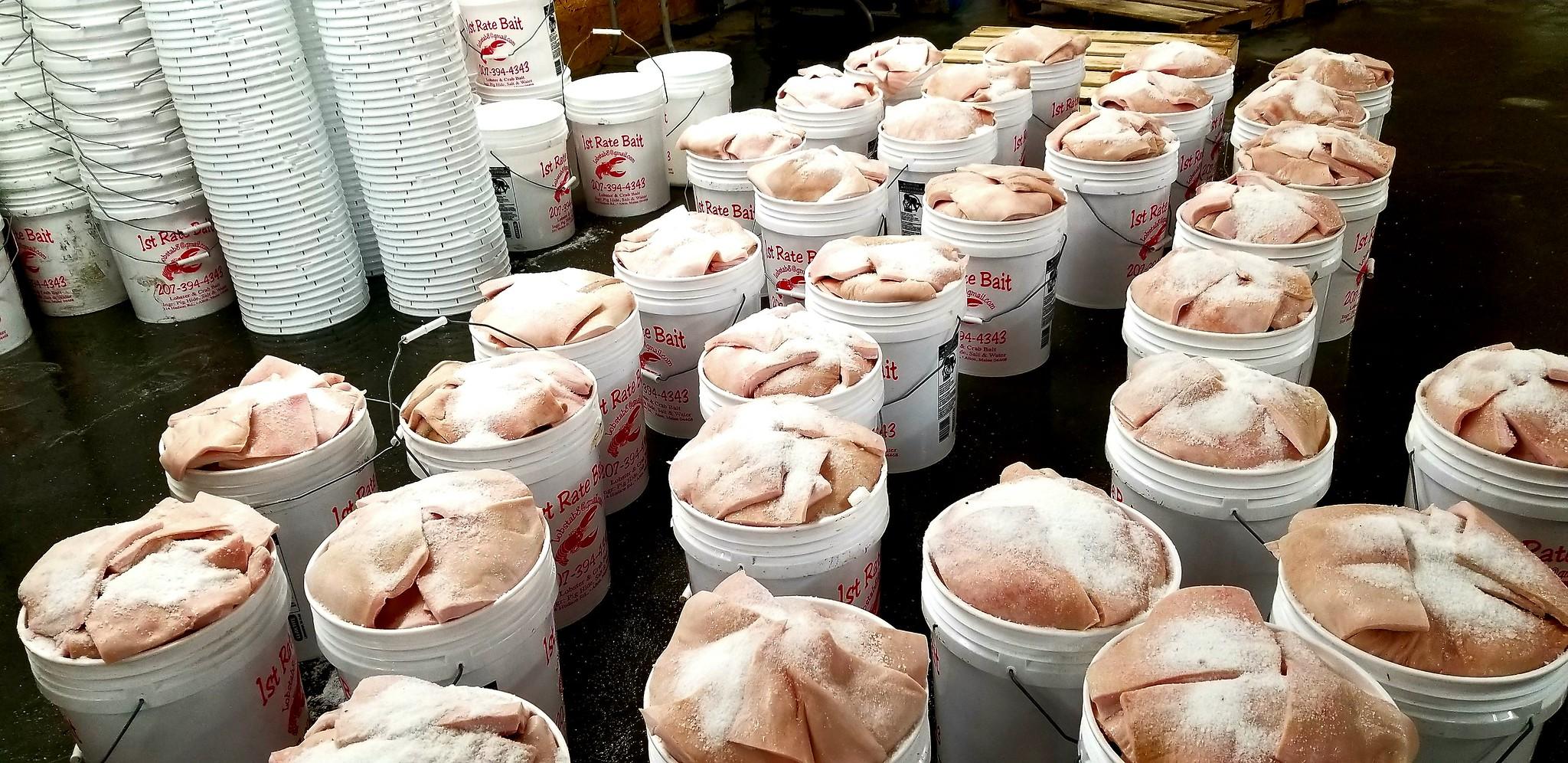
Commercially available buckets of salted pig hide sliced into strips for lobster bait. I have a lobsterman cousin, and he says it really works. Seal might be even better.
fish resources, but they certainly have. In Canada there is a desire to harvest seals to use as lobster trap bait. Pig hide strips are popular bait, and doubtless, seal would be great too. The problem is that the practice would make it illegal to import lobsters to the US due to our marine mammals protection act. Nothing is simple or easy.
Then there is the catch all category. Some people point to river habitat, and there are certainly cases out there of reduced quality river habitat. But there are hundreds of rivers throughout the salmon’s range where populations are shrinking but habitat is more or less pristine. The Miramichi falls into this bucket.
Our own local catch all category is the Miramichi’s – especially the NW branch’s – population of striped bass which spawn just as the salmon smolts are headed to sea. Clearly, this above all else is the Miramichi’s issue.
The Miramichi Salmon Association, First Nations, the New Brunswick Salmon Association and the Atlantic Salmon Federation – among others – are all pressing Canadian DFO officials to bring this population down to 100,000 adult bass from the current estimates of 500K or so. 100K has been shown to be the highest level where the bass and salmon can reasonably coexist naturally. So far DFO is showing little sign of moving very far in that direction even though there is clear evidence that beyond eating up the salmon smolts, striped bass are destroying many other inshore fisheries in Atlantic Canada. Beyond smelts and river herring in the Miramichi, fishermen in nearby Prince Edward Island have seen a 75% decline in their silverside (Atlantic spearing) fishery, and lobster fishermen are complaining that schools of stripers follow their boats eating up the undersized lobster being thrown back.
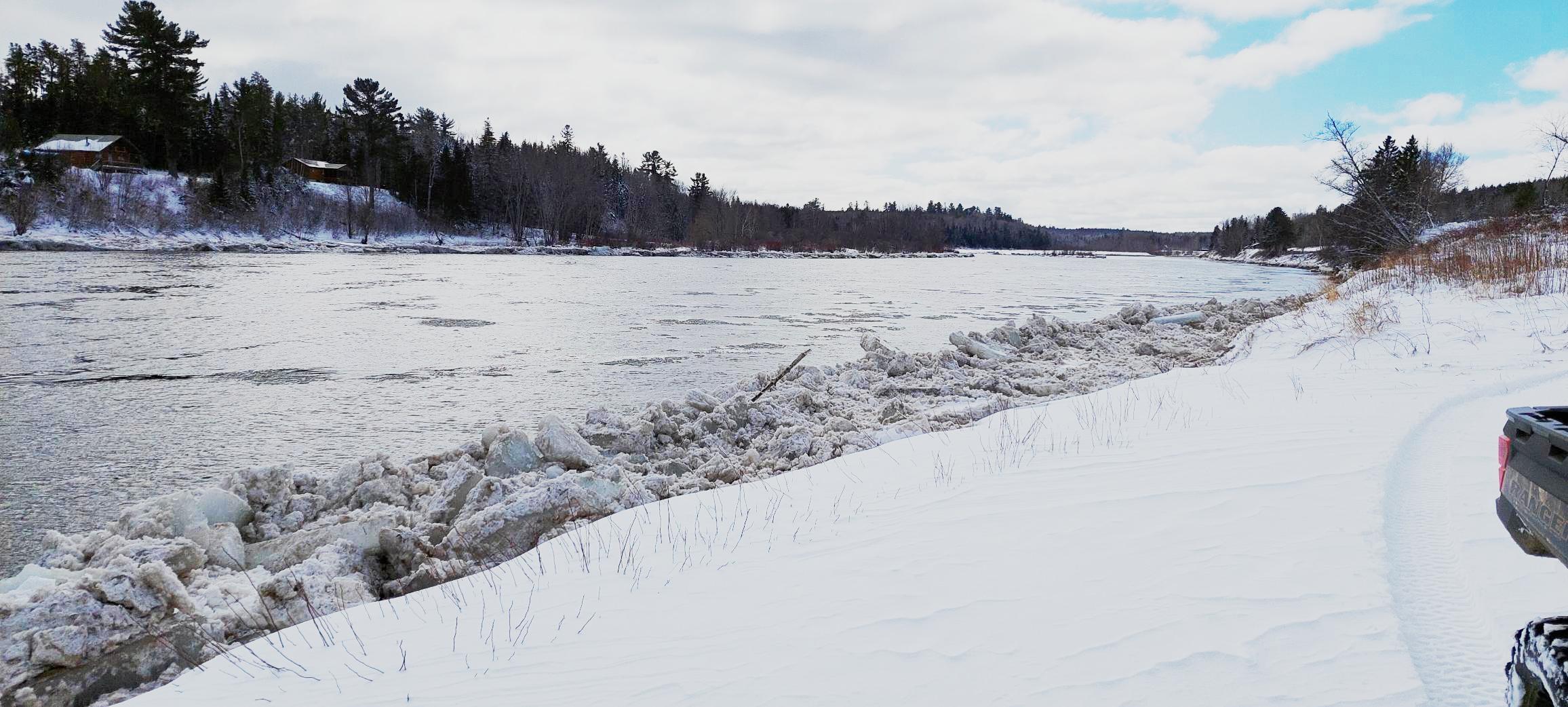
It is very early for all this open water on the SW Miramichi, and with today’s storm the banks will be swept clean.
DFO has stated that they are going to “help” NW Miramichi First Nations fishermen catch their 50K fish annual quota. FN claims that they have not been able to catch about half of this quota because they don’t have enough nets and they aren’t allowed enough netting locations. One answer to much of this in my view is to give a quota to the gasperaux net fishers in the Bay. There is no valid reason why this shouldn’t be done, and done immediately, but I’m not holding my
breath. It is speculated that there will be further relaxations of recreational fishing regulations for bass, especially in fresh water, but we probably won’t know the details of that for a little while yet. It certainly feels to me, though, like the combined effect of these measures will be wholly inadequate to significantly reduce striper numbers.
The recent goods news, though, is that DFO seems to have recognized that something must be done to help Miramichi salmon. Pending the normal health inspections – which the MSA hatchery fish have always passed – it seems likely from their positive comments at a recent meeting that permission will be given to the MSA to stock a considerable number of salmon fry coming from the MSA hatchery into the SW Miramchi this late spring. These fry are the progeny of wild smolts, caught in the SW Miramichi, raised to adulthood in the MSA hatchery, and spawned last fall. At this meeting Dr. Tommi Linnansaari of UNB offered pre-publication scientific proof that fry raised from these smolts were essentially indistinguishable from traditional hatchery fry from wild adults during a point in late summer during their first year as parr. That really shouldn’t surprise anyone as the Miramichi River has been stocked with hatchery raised fry for about 150 years. Some years many millions of fry were stocked into the river, and this is a key reason that the Miramichi has been able to support the world-famous recreational fishery that it is known for. I believe that this new position on the part of DFO is the result of our letter writing campaigns and DFO’s own survey last fall which resulted in their “We Heard Report.” That report showed heavy support for stocking when low population metrics dictated it – as they most certainly do now.
DFO officials also encouraged the MSA to prepare a stocking program for the NW Miramichi. Mark Hambrook, past president of the MSA said that the organization would be glad to assist First Nations with that proposal, and it is in the works.
It should be understood that no one is looking to build a put and take fishery in the Miramichi River. The natural fry incubation capacity of the Miramichi River system is something like 120M eggs or approximately 100M salmon fry. There is also tank space to produce adult salmon that will generate an additional 10 million eggs, but there is not presently sufficient incubation space at the facility for that many. The river, though, is currently being seeded at only a tiny portion of its 120M egg capacity, perhaps as little as 20%, so there is an immense amount of unutilized habitat in the system just going to waste.
No one should be under the illusion that simply stocking will generate a sustainable salmon population on the Miramichi, particularly on the Northwest/ Little Southwest composite (NW/LSW) drainage. A model developed by New Brunswick scientist John Bagnall of the New Brunswick Salmon Council shows that in the face of heavy bass predation, when bass numbers exceed 200,000 adult bass, that fewer than 2% of the outgoing smolts will get by the bass alive to return as adults and become wild spawners. In this situation, even a strong stocking program through capturing and growing wild smolts will not increase the survival rate to the adult spawner stage sufficiently to maintain a self-sustaining population.
We don’t want to be reliant on hatchery production to mitigate the effects of bass forever, but this may be necessary for some period of years into the future. It is imperative that bass numbers be decreased to 100,000 or fewer. According to Bagnall, even at a bass population level of 100,000 the NW/LSW’s salmon population is barely sustainable without a stocking program.
Bagnall’s model shows that the SW Miramichi’s salmon population is a bit more resilient to high bass numbers than is the population of the NW/LSW, but only marginally so. The point of sustainability moves to 200,000 bass from the NW/LSW’s level of 100,000. Currently the bass population is estimated at around 500,000.
Salmon fishing season on the Miramichi system is fast approaching. It seems clear that we will have completely open water this year on all branches of the river right from the beginning of the season. The weather has been a bit crazy with an unusually warm early March causing ice out, then a cold snap nearly freezing it up again, and now warm temps and rain coming that will ice out the NW Miramichi – where the ice is still in – and bring a considerable spring freshet. The good news is that the ice is too far gone to cause any serious scouring damage to the salmon redds.
The question often arises as to whether or not the relatively early ice out has already caused many of the kelts to leave the river. Mark Hambrook has more experience with this issue than anyone I know, and he says no, it has not. Just in case, though, I’m arriving at camp on April 14 and plan to fish the first few days of the season. I bought the upriver, Cains, jet boat trip that Country Haven’s Tyler Coughlan donated to the MSA US auction, and I’m curious to see if we can find a few kelts upriver in the pools where Harry Allen and his crew had some of their best luck 100 years ago. I’ll make a full report on that later.

Among the upriver Cains pools I want to try for spring salmon is the old Arbeau Pool, not far downrvier from the Grand Lake Road bridge. Sturges made this etching of the abandoned farm after fishing with Harry Allen in 1919.
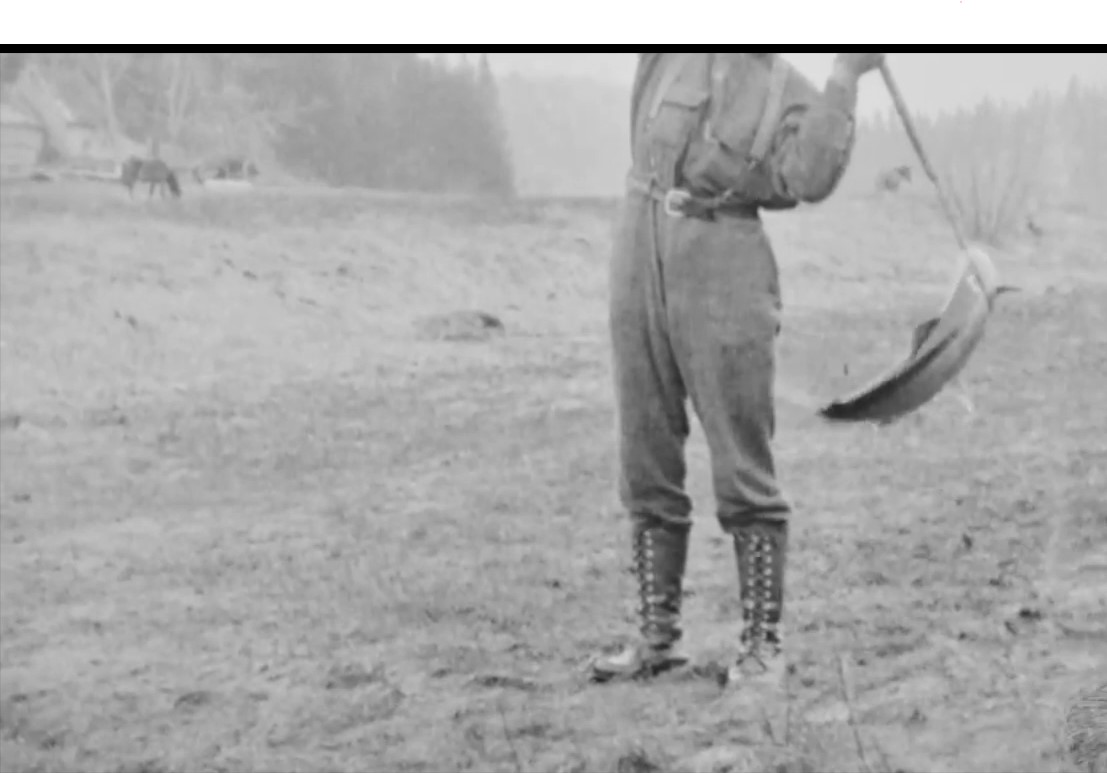
This photo – note Arbeau Farm buildings in upper left corner of photo was taken in 1916. You can see that the farm may have been lived on at that time by the blanketed horses, though they might also have belonged to a lumber crew. This photo shows a young George Allen gaffing a kelt from the pool.
One thing about the kelt fishery that I find interesting is how some of the very biggest salmon that you ever see on the river are caught and released as kelts. I remember reading an article by a Norwegian salmon scientist who theorized that some salmon will simply never take a fly upon returning to their spawning river whether it is their maiden return or 5th repeat spawning run. You will occasionally see these immense fish jumping as bright fish – especially in the fall – but extremely few are ever hooked. These same fish, though, start to feed actively as kelts – if they survive spawning and wintering in the river – and it is then that we have a crack at catching them. For many long-time Miramichi anglers the biggest salmon they have ever landed was a kelt.
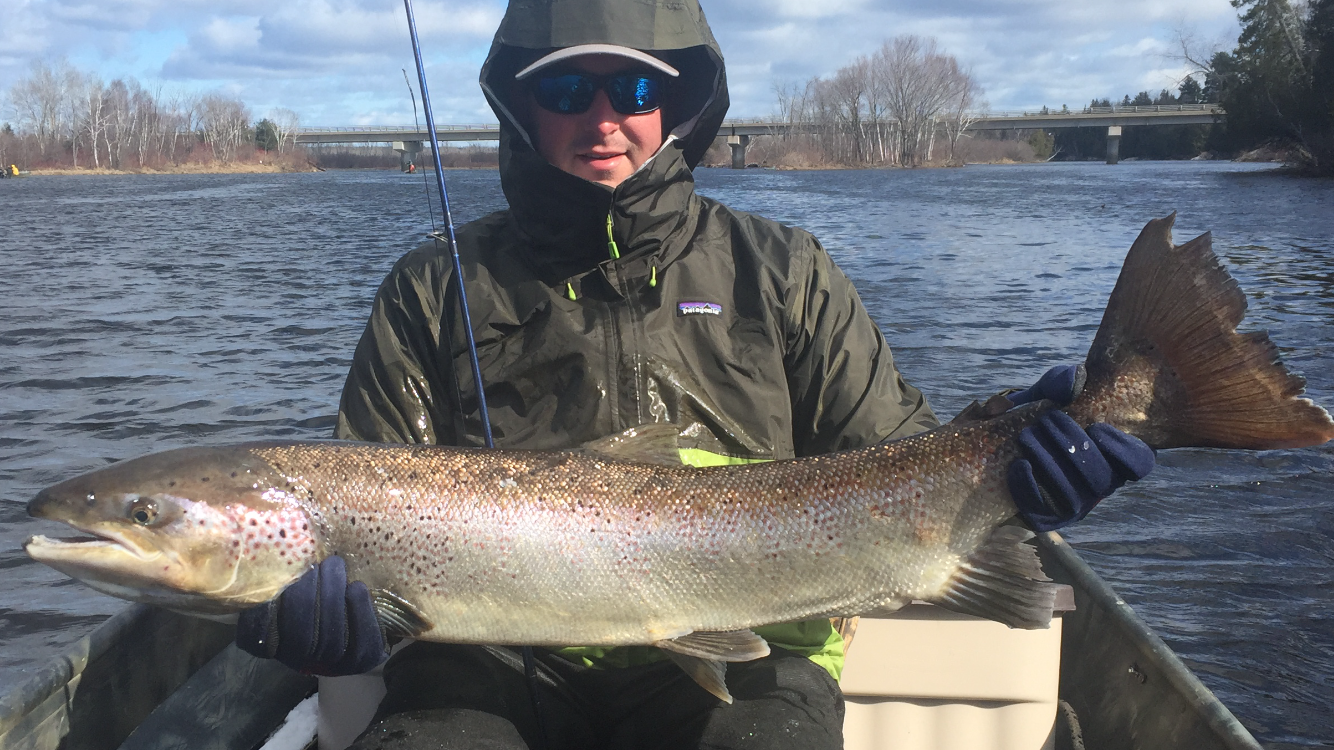
Here is a case in point on kelts that have never been willing to take a fly as bright fish. This NW Miramichi kelt was 55 inches long. How many 55-inch bright salmon have you ever seen or heard of caught on the Miramichi or anywhere else? It would have been gigantic as a June salmon, probably weighing over 50 pounds.
It’s back to Scotland for me this coming weekend to fish next week on the River Helmsdale. Reports for this week so far, according to the Heron of the Thurso Pat Nicol, are 5 fish on Monday and Tuesday from the Helmsdale. By modern standards that’s not bad for 12 rods during only the first 2 days of the week. Three of these fish came from Beat 1, the most seaward beat, so there is some optimism that new fish are entering daily.
At the MSA US Dinner in February, Michael Wigan, river manager of the Helmsdale and owner of Borrobol Estate which has two rods on the river, outlined the river’s long standing hatchery policy. They electrofish areas that have historic documented levels of parr, and stock fry in the areas where there is an apparent need. Thank god for simple, common-sense solutions! The mighty River Dee, one of the world’s historically great salmon rivers, fishes 200 rods a day, or about 15 times as many as the Helmsdale, had 18 springers last week compared to 7 for the Helmsdale. The success rate of the average angler on the Helmsdale was approximately 7 times greater than on the Dee. Things were so good on the Dee 20 years ago that it was decided to end their hatchery stocking which had supplemented the river for 100 years. Now, as I reported a couple of blogs ago, they are undertaking a whole new and aggressive stocking program in response to diminishing returns.
In fairness this is not a reflection on the quality of the Dee as a salmon river. A study I recently read on the Girond Burn – historically a major contributor of Dee River springers – showed that since the 1960s adult returns to this tributary stream have declined by some 80%. Parr production in the burn, however, has declined less than 50%. This is essentially the Miramichi’s problem. No matter how good your habitat is a dearth of spawners will eventually knock down the number of parr living in the stream. Yes, with extra room and food available for the fry you will have better survival and growth rates, and that will mitigate the situation to some degree. But you must have eggs to eventually have smolts. If ocean conditions are causing a shortage of returning adults, and the river’s habitat is not being fully utilized, than common sense says that you do what you can to add more eggs/fry/parr or whatever life stage you believe is correct to stock with.
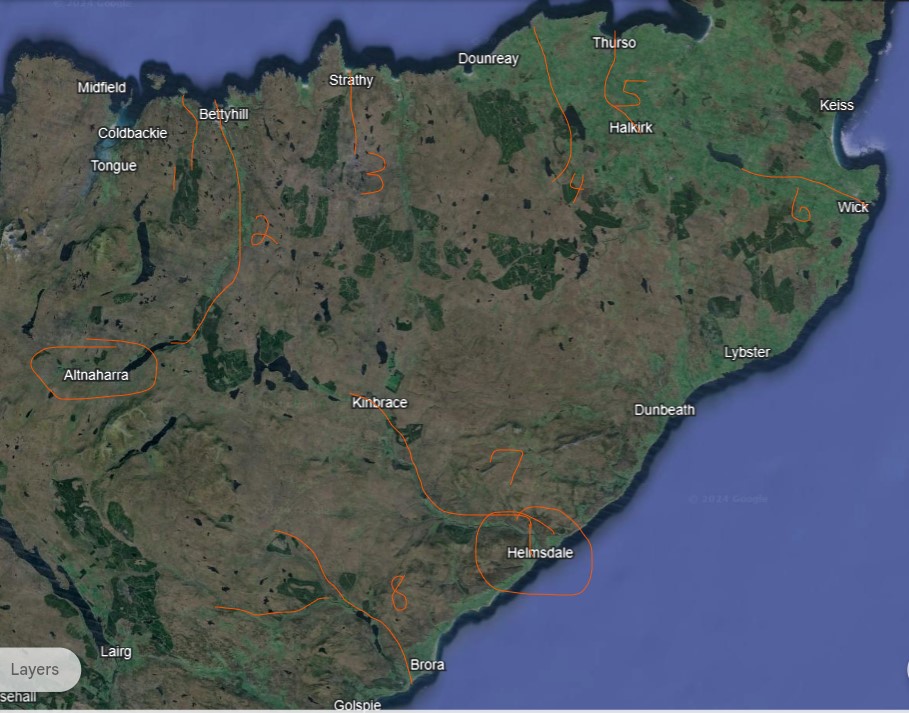
The northeast part of the Scottish Highlands I’m most familiar with. From upper right, #1 River is the Borgie, #2 the Naver, #3 the Strathy, #4 the Halladale, #5 the Thurso, #6 the Wick, #7 the Helmsdale, #8 the Brora
While on the Helmsdale Michael Wigan is taking Ralph Vitale and me on a little ride out through the interior of the Borrobol Estate that includes some of the spawning headwaters of the nearby Brora River – made famous by fly tier Megan Boyd. I’m very much looking forward to seeing this remote section of the Northern Highlands, especially with some of salmon spawning streams. I will be clicking away on the camera at every opportunity. If I get some good shots I’ll do a special blog about it.
It is indeed time to get ready for salmon fishing! Every fall I carry home my salmon fly tying materials from the Miramichi, but in the last couple of years I’ve been busy all winter, and I just haven’t got around to much tying. This year is only a little bit of an exception. After discovering that I was a bit low on a few of my favorite Miramichi summer salmon flies, I tied up some John Olins in sizes from #2 down to #10. I also tied Black Ghosts – historically one my most successful salmon flies in the same sizes. Additionally I tied up some of the secret fly of a number of BBSC’s old-timers, the AVP or A Variant Preacher… Last I tied up some of my very favorite early fly which is the Silver Rat. Those are not in the photo because they are already stashed in my fly boxes. I’m really looking forward to trying them all out.
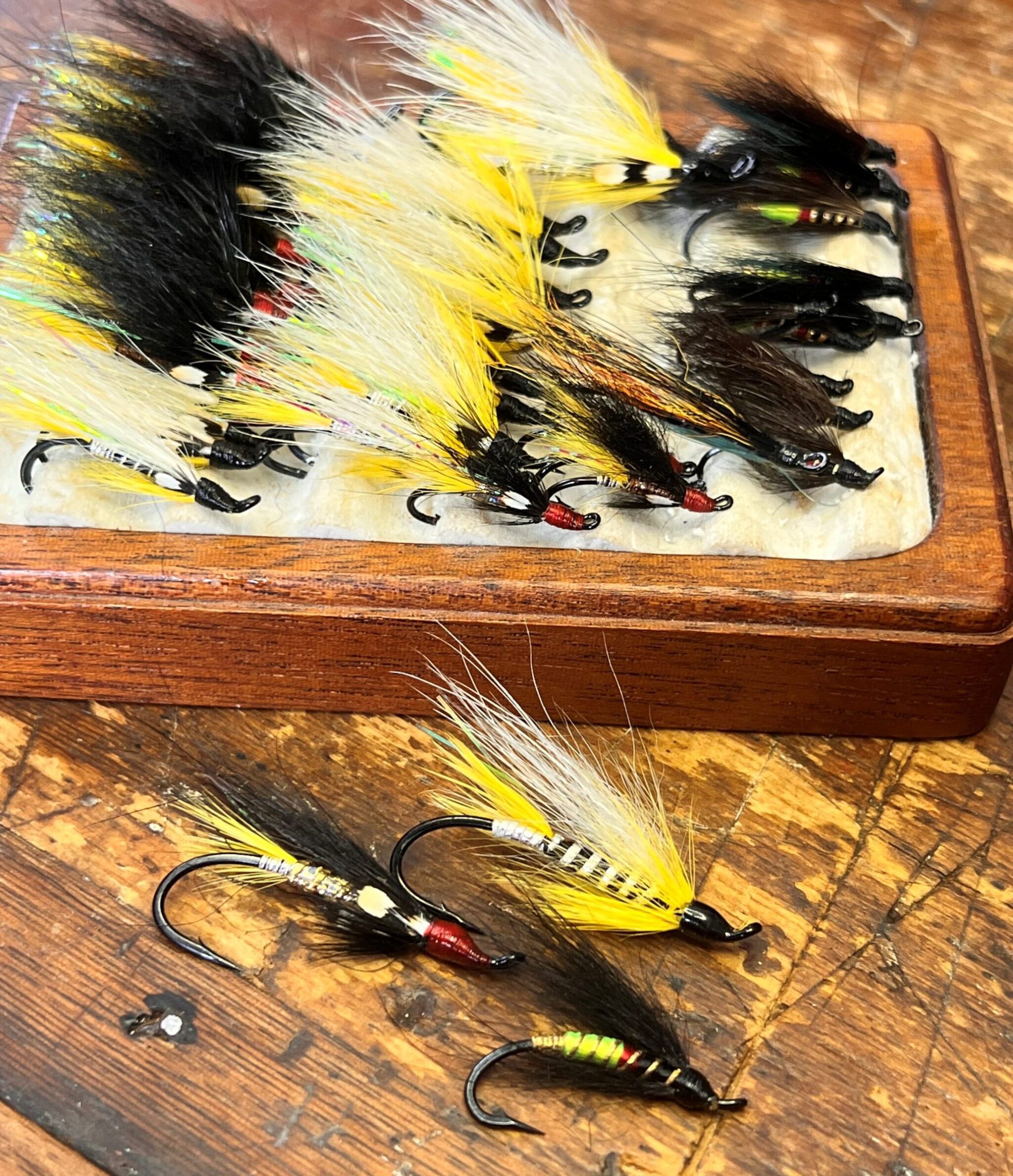
A little recent fly tying. I have promised not to give out the recipe for the AVP, but I can tell you that I doubt the differences between it and regular Preacher are worth mentioning…
Thanks for reading. Brad Burns
PS – If you haven’t already booked dates at your favorite Miramichi Lodge, now is the time to get that done. You can read all about a selection of the best Miramichi lodges and outfitters at this link FishPal – Canada – Fisheries.
Historically everyone wanted to be on the Miramichi in the fall. Fall is still a great time on the river, and one of most active fishing stretches in 2023 was on the Cains River tributary during the last week of September. It is clear to me, though, that the early season has gained in consistency and importance to the fishery. Don’t overlook the time frame from June 15 to July 15. This has produced a lot of the best fishing in recent years, and without question the salmon then are in the very most prime physical condition.
Also, if you aren’t getting notices of updates to my blog – or have a friend who isn’t – just take a second and sign up right here. There is no charge.
If you want to make a comment on the blog, please don’t hesitate. Comments can be made right after the end of the blog in the space provided and clearly marked. I hope to hear from you.


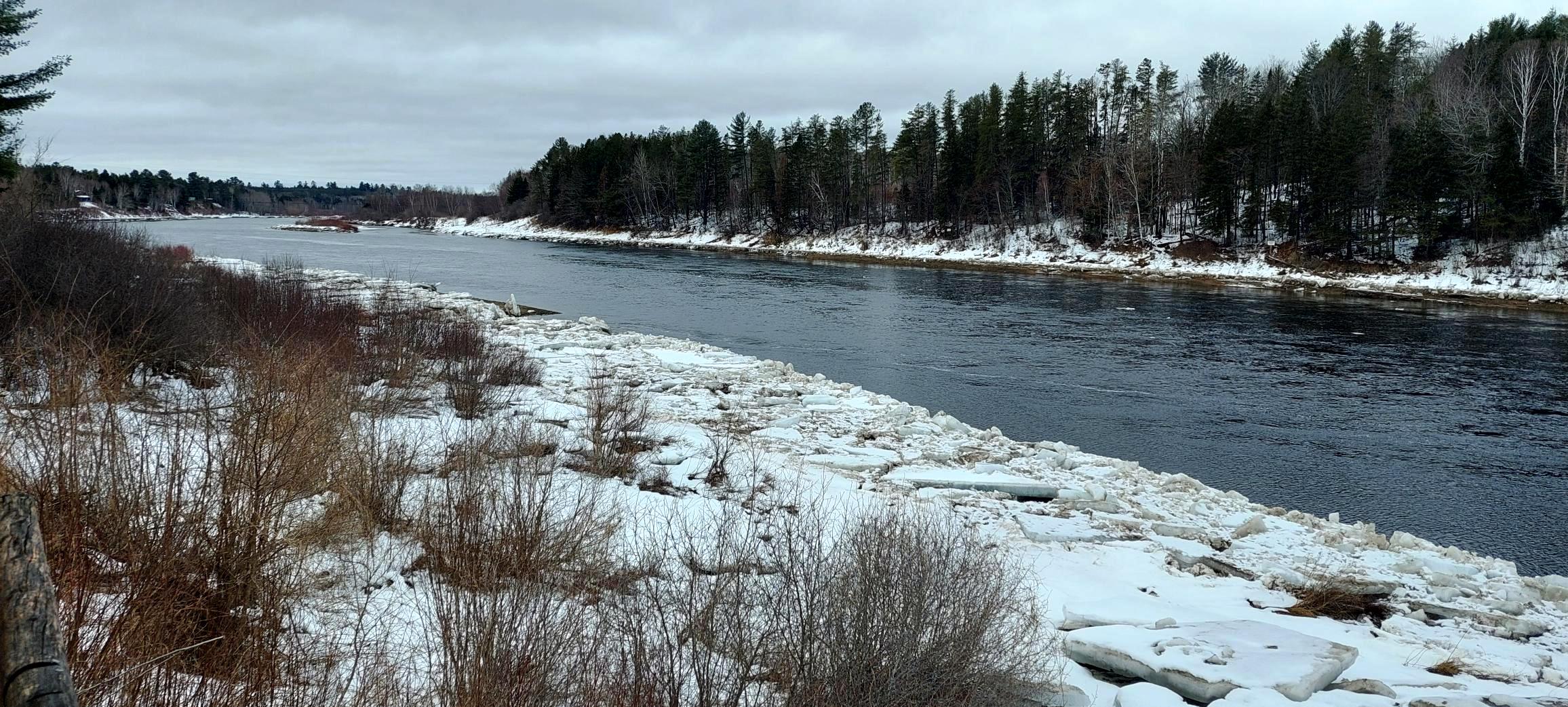
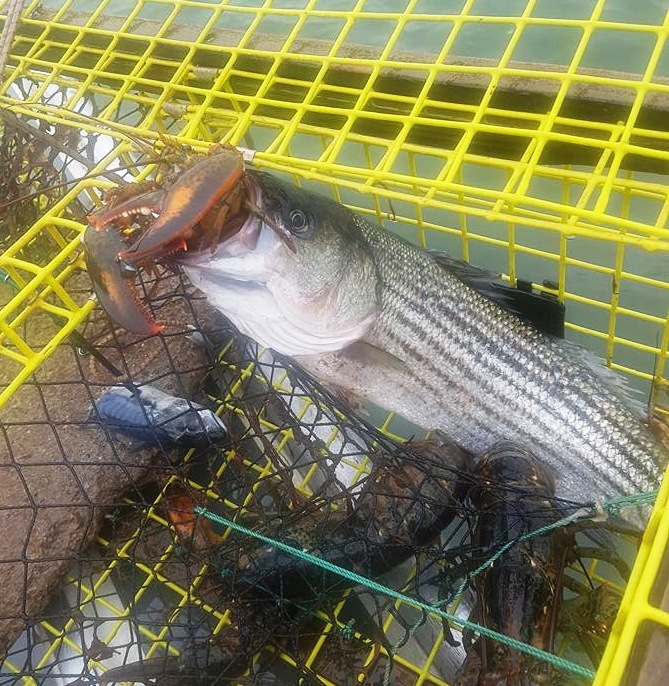
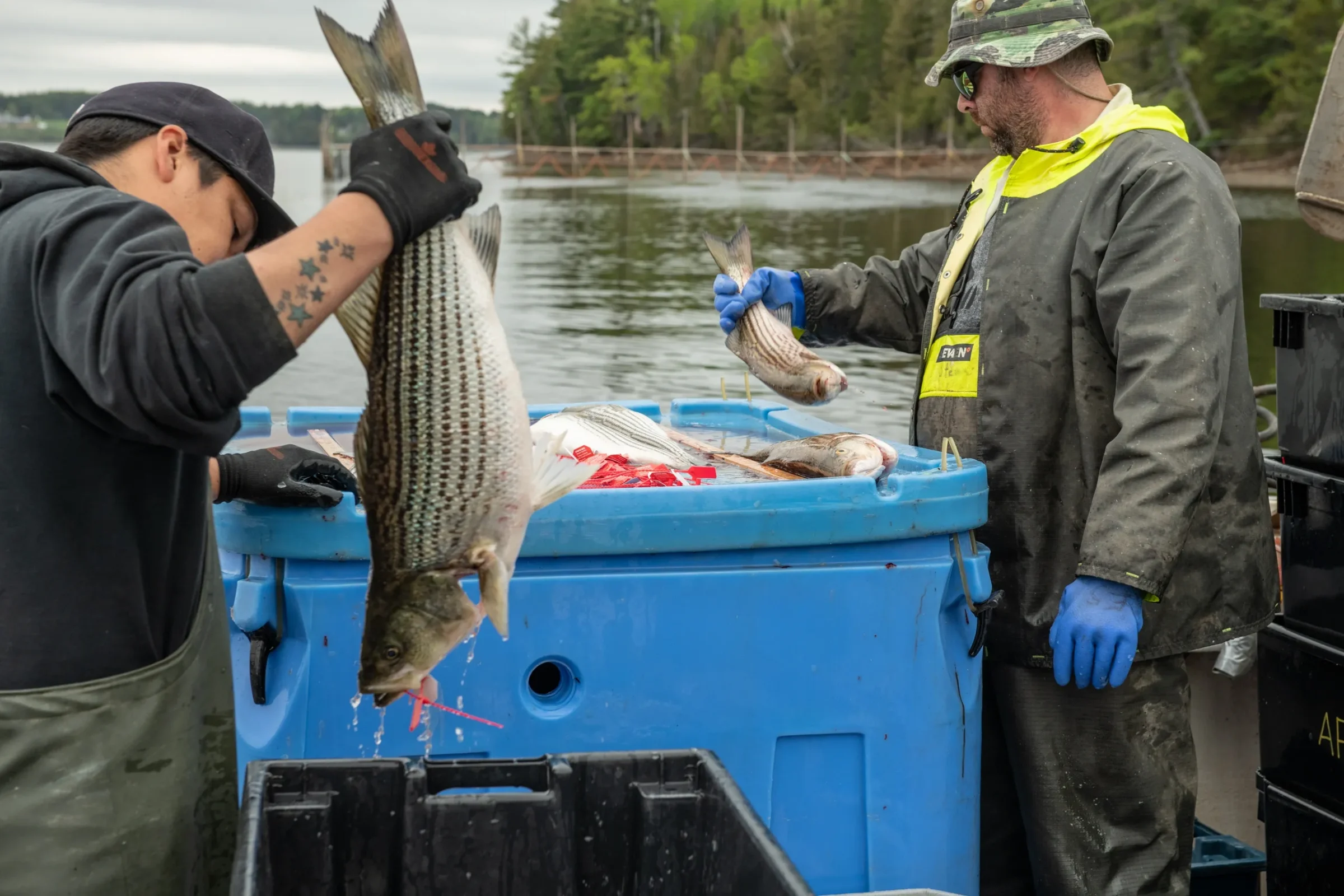
Good luck on the Helmsdale. My father used to fish the Brora quite often and had a nice collection of Megan Boyd’s classic flies. I understand that beyond being a very accomplished tier, she was also quite a character.
Thanks for the note Rip. I didn’t know that Mac fished the Brora. My friend Pat Nicol used to buy flies from Megan. He said that she always wanted to meet him at a local coffee shop to deliver the flies. She brought her friend along, and Pat would treat the two of them to coffee and a pastry. It was part of the deal. The flies were second to none.
Thank you for this well assembled and researched piece Brad.
Thanks Dwayne. It’s a labor of love. Best of luck this year to the DSF! One of these years I’ve got to make your smelt fry. Brad
BRAD, in your typical leadership of fisheries, you have drawn me in. Your detailed analysis is always full of logic. I no longer have the ability to cast a fly, but love following the game through your blogs. BIG THANK YOU.
Dougjowettcomcast.net
Brad, You are largely correct in your assessment of the striped bass situation on the Miramichi, although I would suggest a change to allow legalized retention of any striped bass of any size caught above Blackville or Doaktown. The fish do not belong there and they are preying on trout and parr throughout the summer upriver. The locals would love to retain such good eating fish, regardless of size.
You could not be more wrong about the health of the headwaters. The headwater problems above Boiestown involve reduced buffers along with massive clearcutting of large swaths of forest. Couple that with aerial spraying of glyphosate on those deforested grounds, and you have a damaged, sick biome. Runoff has increased with resulting siltation of the river and feeder streams. The river flow and temperature now fluctuate widely over the summer months. The denuded headwater ground has lost its water retention capacity.
Glyphosate is herbicide poison and kills plants and fungi, which are critical for the long term health of the soil. That poison lingers in the ground for years. Glyphosate has been banned in other provinces and across Europe. Think back to the days of aerial spraying of DDT. People in the valley are still dealing with increased cancer diagnoses decades later. This is a very similar problem now with herbicide rather than insecticide before. These issues need to be addressed by the Province, and if addressed now, these problems will take decades to ameliorate.
Howard – I certainly agree with you about Glyphosate. I don’t understand why the legislature in NB doesn’t ban it. That said, the system is still producing lots of fry and parr. I’ve been watching it carefully for years. While it is anecdotal, I don’t see any large decrease in the amount of parr in the river during the summer. Yes, there are less than 20 years ago, but we still see lots. Our single biggest problem is that the smolts aren’t getting by the bass. Brad
Brad
That you for your report. Like most salmon fishermen, I read any current salmon report with my fingers crossed for any hint of good news. The move towards increased stocking is a bit of good news, but … I fear these fish will simply become more food for those rats of the river known as stripers. Hopefully, decisions will soon be made (unlikely) to mitigate the ovetpopulstion of the stripers. Tol then any striper hooked about the head of tides shouldn’t make it back into the river in a healthy condition.
Bob – I do hear that the above head of tide changes you talk about may come to pass in one form or another, but even those changes would be insufficient. Giving the gasperaux trap nets a substantial quota in addition to the FN quota is what really needs to happen. Brad
Thanks Brad , Enjoy your Scotland adventure and please give Michael my best.
Luther
Aye, will be sure to do!
Thanks as always Brad for your insights … the importance of your leadership on Atlantic Salmon on the Miramichi cannot be understated … you have enabled and led the rallying cry necessary to get the attention of DFO which hopefully will translate into meaningful action and change. Fingers crossed for our salmon!
Thanks for the report,lets hope that DFO does what they were developed to do……as you know I have the White Birches for the first week in July, any suggestions as to what I should fish there? Haven’t tied for many years now but am about to give it another try…..any suggestions would be appreciated…..keep doing the blogs…thanks Mac
Great to hear from you Mac. I think that DFO has a very hard time deciding what exactly they are supposed to do, but we are certainly telling them what we think is the right course.
I would think that the selection of flies at White Birch would be pretty much the same as at the MSC. The first week in July can be low, warm water, or it can be running high and cool or anywhere in between. Normally we are seeing the season progress to lower, warmer water and therefore smaller flies. Dry flies can also be important – they were in 2023 at that time. I’d have at least a few bombers in natural deer hair, brown hackle, and with white tail and wings, tied on #2 and #4 streamer hooks. I’d also have the same sizes in green body with orange hackle.
For wet flies the traditional green machines and blackish wet flies should do it. I really like the Black Ghost and Black Bear Green Butt. You should have some in #4, #6 and #8. I doubt you will need to go below that. Same sizes in Green Machines, some of which should have krystal flash tails, and some white bucktail. Any fish that you are likely to encounter should be quite fresh.
I’d also check with Clarence Curtis at the lodge. He is very friendly and helpful. Brad